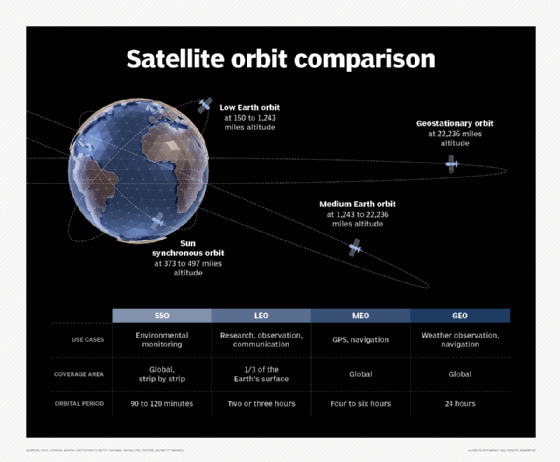
Getty Images/iStockphoto
An introduction to satellite network architecture
Satellite network architecture consists of three segments: space, ground and control. Satellite networks enhance networking beyond terrestrial network capabilities.
Satellite networking is a digital revolution that connects people from across the world instantly -- from enabling real-time communications to making the world a safer place.
A satellite is an artificial object put into the Earth's orbit to gather and distribute crucial data. Since the late 1950s, satellites have only transmitted and received data, as bent pipe satellites weren't able to perform other functions. In modern times, a group of satellites in the same orbit forms a satellite network.
Satellite networks process data and provide accurate visual and textual information. Unlike terrestrial network infrastructure, satellite network scalability isn't limited by geography and cost. According to a March 2025 report from Goldman Sachs, the global satellite market is expected to hit $108 billion by 2035, growing sevenfold from its current valuation.
Satellite networks consist of the following:
- The ground equipment.
- The satellite itself.
These segments include everything that enables efficient communication between the ground equipment and the satellite.
Modern satellite networks offer enhanced capabilities and connectivity, serving various industries, such as news broadcasting, weather forecasting, agriculture, energy and finance.
Satellite network architecture components
A satellite network architecture has three main segments:
- Space.
- Ground.
- Control.
Some experts divide the architecture into space and ground segments and include different parts of the control segment in their respective environments -- ground or space. This article covers satellite network architecture components using the three-segment model.
1. Space segment
The space segment is the part of the satellite network present in space. It consists of the launch vehicle, orbiting satellite and communication links between the satellite and the Earth.
Launch vehicles don't remain a part of the satellite network; their only job is to put a satellite into orbit. This means launch vehicles can be considered expendable or reusable, as well as medium lift or heavy lift.
Once in orbit, the satellite is the core of the space segment. It orbits around the Earth to gather, process and transmit data to the Earth or other orbiting satellites. Satellites must withstand challenging space conditions and exhibit long equipment life for seamless operation. To do so, satellites withdraw operating electric power from solar cell arrays connected in series and parallel configurations. They also contain nickel-cadmium batteries.
Due to continuous operation and direct, prolonged exposure to sunlight, satellites heat up considerably. Moreover, high-power electronic components dissipate heat. Satellites use insulators such as thermal blankets and radiation mirrors to control heat.
Satellite payloads refer to all the equipment and systems on a satellite necessary to accomplish a mission. They perform the job for which the satellite was launched into space. The bus system supports the satellite and keeps it operational in orbit.
The satellite's orbit heavily depends on its services and use cases. Satellites are known by the name of the orbit they operate in. Orbit types include the following:
- Low Earth orbit. LEO satellites have an altitude of 150 to 1,243 miles above Earth. Some LEO satellites can reach over 3,000 miles, but most have an orbital period of two or three hours. LEO satellites are fast enough to offer less delay and path loss -- ideal for research, observation and communication.
- Medium Earth orbit. MEO satellites operate in a range of 1,243 to 22,236 miles above Earth. They have a longer orbital period of four to six hours. MEO satellites provide global coverage for GPS and navigation.
- Geostationary Earth orbit. GEO satellites have an altitude of 22,236 miles above Earth and a synchronous orbital period of 24 hours. Due to their extensive coverage, they're ideal for weather observation and navigation.
- Sun synchronous orbit. SSO satellites are lightweight, low-orbit satellites at 373 to 497 miles above the Earth. They maintain a consistent relationship -- known as synchronization -- with the sun and can cross a given point at the same time every day. SSO applications include remote sensing and environmental monitoring.

While launch vehicles and satellites are physical components of the space segment, satellite links are signal pathways. Satellites operate at high frequencies ranging from 1 GHz to 40 GHz and cover the range of microwave frequency bands. In a satellite network, the uplink and downlink points define the signal transmission direction between the satellite and the Earth:
- Satellite uplink. The signal that moves from the Earth to the satellite at a higher frequency, usually 6 GHz. The uplink frequency is the frequency at which the Earth station sends a signal to the satellite.
- Satellite downlink. The strong signal sent back to the receiving Earth station, usually at 4 GHz. The downlink frequency is the frequency at which the satellite sends back the data to the Earth station.
Uplink frequencies are higher than downlink frequencies. However, the uplink signal is weak due to attenuation. The satellite receives the weak signal, amplifies it and then transmits it back to Earth at a reduced frequency. The difference between uplink and downlink frequencies avoids signal interference.
To perform its three main functions -- receiving, processing and transmitting data -- the satellite transponder is a critical component. It is a transmitter-receiver subsystem of a payload that enables signal amplification and retransmission. A satellite network consists of about 24 transponders in two sets of 12. A typical transponder has a bandwidth of 36 MHz.
2. Ground segment
The ground segment functions like a satellite interface. It consists of all the ground equipment that helps to communicate with the orbiting satellite, such as the following:
- Ground stations.
- Antennas.
- Terrestrial networks.
- User terminals.
A ground station, also known as an Earth station, is a facility on the Earth that sends and receives data to and from an orbiting satellite. Ground stations are either fixed or mobile. Mobile stations include flying aircraft, ships traversing the sea, and military or commercial stations. The nature of the Earth station depends on the type of service the satellite network provides.
Ground stations are strategically placed to maintain constant communication with the orbiting satellite. However, their function isn't limited to transmission and reception. Ground stations also contain high-powered equipment to process satellite data, including the following:
- Amplifiers.
- Converters.
- Modulators.
- Demodulators.
- Encoders.
- Decoders.
The ground segment also has highly directional parabolic dish antennas pointed toward the orbiting satellite. This ensures unobstructed, direct and constant communication. These antennas are placed at high altitudes underneath open skies for high-gain and long-range communication.
Gateway stations connect satellite networks to terrestrial networks -- the land-based network infrastructure through which end users access satellite-based services. The terrestrial network's primary function is to distribute data received from the satellite to various users. Examples include fiber optic networks, 5G millimeter wave and microwave line of sight (MLOS) links.
End users are consumers who connect to terrestrial networks to gain access to satellite data. Sometimes, end-user devices contain user terminals in the form of customer premises equipment to directly access satellite network data. Examples include direct to home (DTH) satellite TV, GPS and military units.
3. Control segment
The control segment is also found on Earth and isn't carried by the satellite. It consists of the components that control, monitor and maintain the satellite's health and performance throughout its lifecycle. The control unit is the core of the satellite network that keeps it operational.
The control segment includes the following components:
- Telemetry, Tracking and Command (TT&C) stations. Telemetry receives satellite data about its health, such as battery condition, currents and voltages, operational temperature and pressure. Tracking continuously tracks the satellite's position and orbit in relation to Earth. Command sends instructions to the satellite to automate health-related tasks.
- Altitude and control propulsion. These units ensure satellite antennas and solar cells face the correct direction. If necessary, this control unit performs station keeping, altitude control and correction.
- Thermal control. These units maintain suitable temperature ranges for all subsystems, payloads and satellite sections, whether operating in space or not.
- Network operations centers. NOCs are centralized hubs used to monitor, manage and control the ground segment's performance. While the orbiting satellite needs utmost care, ground segment performance is crucial for satellite networks. NOCs also monitor traffic flow in a satellite network.
- Multiple access techniques. Both satellite payloads and ground stations use multiple access techniques to enable multiple users to share satellite channels efficiently. In this context, multiple users are end users and other satellites in the constellation. Satellite networks use fixed and on-demand assignment modes to allocate satellite communication bandwidth. Some of the multiple access techniques satellites use include time-division multiple access, frequency-division multiple access and code-division multiple access.
Inter-satellite links
An inter-satellite link (ISL) is a space-based network that enables multiple satellites to communicate with each other. ISL offers direct satellite connectivity, eliminating the use of ground stations. Reducing reliance on terrestrial equipment and networks facilitates many services, such as global coverage, data relay and ultralow latency. A group of satellites in the same orbit forms a satellite constellation -- a term inspired by stellar constellations.
Satellite network topology
Satellite networks have three types of topologies:
- Mesh satellite network. Each satellite connects to multiple other satellites. Mesh topology promotes ISLs and reduces redundancy. However, it forms a transparent and decentralized network, which relays signals without processing.
- Star satellite network. All Earth stations exchange data through a centralized satellite known as the hub. Typically, four Earth stations connect to a hub. Any problem in the hub can cause network downtime.
- Hybrid satellite network. The hybrid approach combines star and mesh topologies.
Satellite network layers
The OSI model provides a standard on which the satellite network architecture is based. The OSI model acts as a blueprint for the satellite architecture model, which expands to more specifically represent the unique requirements of satellite communications:
- Radio layer. The radio layer is the physical layer of the satellite network. It consists of transponders, satellite links, baseband equipment and the necessary hardware on the ground and onboard the satellite for communication. The radio layer uses mLOS for satellite communication.
- Data link layer. The data link layer maintains data integrity through framing, multiplexing, and error detection and correction.
- Network layer. The network layer covers networking protocols. Its main function is to perform routing and addressing among ground stations, satellites and satellite constellations.
- Transport layer. The transport layer ensures reliable data packet delivery. TCP, User Datagram Protocol and other protocols ensure reliable data transmission and reception. However, in satellite networks, transport protocols have a slow start and delayed acknowledgment.
- Session layer. The session layer manages multiple sessions, such as multiple mobile stations in a single satellite network.
- Presentation layer. The presentation layer is responsible for satellite data security. It manages data formats, encryption and decryption, as well as encoding and decoding.
- Application layer. The application layer ensures satellite service distribution to end users, such as TV broadcasts, DTH, GPS and weather forecasts.
Satellite network use cases
Satellite communication dates back to the 1950s and 1960s with the launch of Sputnik 1 and Telstar 1. Satellites have various use cases in the 21st century, including the following:
- Navigation. The most popular and common use of satellites is GPS on phones and laptops. Compared to the 1990s, GPS tracking and instant location sharing have made life easier and safer.
- Internet access. Satellite networks enable faster internet access in rural areas, supporting rural education and telemedicine capabilities.
- Military. Satellites have historically been included in military applications.
- Satellite IoT. Satellite IoT ensures reliable data exchange in remote or less-populated areas where terrestrial networks are unreliable. It also runs AI and machine learning workloads with low latency in remote areas that are deployed with IoT devices.
- Advanced imagery. Satellite networks provide clear and processed images of areas less visited by humans.
- Weather prediction and environmental monitoring. Satellites take accurate and extensive photographs of features of the Earth. This type of data helps forecast the weather.
- Space research. Satellites embedded with advanced equipment regularly monitor space and the solar system. Recreational space travel is almost possible -- satellite networks will help with effective communication between users in space and on the land.
- Agriculture. Satellites monitor cropland resources to help the agricultural sector.
- Live broadcast. Low-altitude satellites cover live events to offer an enhanced experience to end users connected through TVs and mobile phones.
- Maritime industry. Satellite networks help ships navigate the ocean. Quick communication and navigation support long voyages for logistics and commercial ships. Satellites can instantly detect distressed vessels to initiate quick rescue operations.
- Finance. Satellites can support fast financial operations, like instant money transfer, digital ATMs and secure financial data management.
- Energy and utilities. Satellites already use solar technology for efficient data exchange and management.
- Mining. Advanced images and data from satellites help to survey remote and untouched areas for mining.
Venus Kohli is an engineer turned technical content writer, having completed a degree in electronics and telecommunication at Mumbai University in 2019. Kohli writes for various tech and media companies on topics related to semiconductors, electronics, networking, programming, quantum physics and more.







